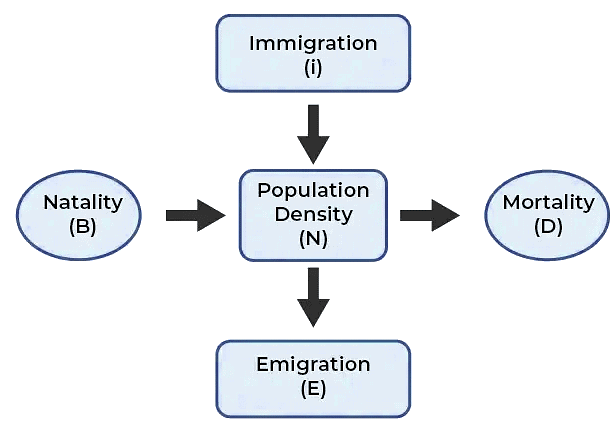Population Growth | Biology for JAMB PDF Download
| Table of contents |

|
| Introduction |

|
| Organisms |

|
| Populations |

|
| Population Growth Models |

|
| Exponential Growth |

|
| Logistic Growth |

|
Introduction
Population growth is the phenomenon wherein the number of individuals residing in a specific area expands over a defined period. This trend is fundamental to our world dynamics as human population is inherently dynamic. Multiple factors influence population growth, including climatic conditions, food accessibility, and the presence of predators. Population density fluctuates over time due to four primary processes: natality and immigration lead to population growth, while mortality and emigration result in population decline.
Organisms
Organisms are living beings that are capable of functioning on their own.
A population comprises individuals residing in a specific environment capable of sustaining their presence. It constitutes a collective of organisms belonging to the same species. Together, populations form communities that govern ecosystem functions. Ecosystems encompass both living (biotic) and non-living (abiotic) elements. This group of organisms forming a population encompasses plants, animals, bacteria, humans, and fungi.
Populations
A population possesses distinct characteristics unlike an individual organism. While an individual experiences birth and death, a population exhibits birth rates and death rates. In population dynamics, these rates indicate the number of births and deaths per individual. Another notable attribute of populations is the sex ratio, contrasting with the binary classification of individuals into male or female. Populations consist of individuals spanning various age groups. When plotted, this age distribution forms an age pyramid, depicting the distribution of ages among males and females within the human population.
Population and Attributes
- The gender ratio refers to the total number of men and women per 1000 individuals.
- The birth rate refers to the total number of individuals born in a certain period of time.
- Death rate refers to the total number of deaths in a certain period of time.
- A plot showing age distribution is known as an age pyramid.
The population size of a species fluctuates over time due to diverse factors like weather conditions, food availability, and predation pressures. Consequently, population density varies over time due to shifts in four fundamental processes. Natality and immigration contribute to population growth, while mortality and emigration lead to population decline.
Natality: It refers to the number of birth rates during a given period in the population that are added to the initial density. The birth rate is also known as Natality. It is the rate of birth, germination, or vegetative propagation of an individual.
Natality = Number of births per year / Number of population per year * 1000
Immigration: This term refers to the influx of individuals of the same species into a habitat from elsewhere within the specified time frame. It results in an augmentation of the population size and is characterized by inward movement, thereby contributing to population growth.
Mortality: This pertains to the rate of death per thousand individuals within a population during a given period, typically annually. It leads to a reduction in population size and is computed based on deaths occurring within a specific area. Mortality is synonymous with the death rate.
Emigration: Emigration denotes the departure of individuals of the same species from the habitat to elsewhere within the population during the specified time frame. It results in a decline in the population size and is characterized by outward movement, thus acting as a deterrent to population explosion.

N is the population density at time t, then density at time t+1 is
Nt+1 = Nt + [(B + I) – (D + E)]
Population Density will increase if the number of birth plus the number of immigrants (B + I) is more than the death plus the number of emigrants (D + E).
Population Growth Models
Population growth is influenced by factors such as food availability, habitat conditions, and various biotic and abiotic elements. Different models are employed to depict population dynamics, categorized into two types:

Exponential Growth
This type of growth occurs when there is ample space and food available. The population expands exponentially and geometrically. If the population size is represented by N, with a birth rate denoted as 'b' and a death rate as 'd', then the changes in N over a unit period of time 't' can be expressed as:
dN / dt = (b – d) * N
let (b – d ) = r, then
dN / dt = rN
where r = intrinsic rate of natural increase,
This equation is represented in a graph that features a J-shaped curve.
According to calculus,
Nt = N0ert
where Nt = Population density at time t,
N0 = Population density at time zero,
e = base of natural logarithms,
r = intrinsic rate of natural increase.
Logistic Growth
Logistic growth occurs between the individuals of a population for food and space. This type of growth shows a leg phase followed by acceleration and de-acceleration.
dN / dt = rN * ((K -N)/ K)
where r = Intrinsic rate of natural increase,
N = Population density at time t,
K = carrying capacity,
The growth of the population is finite these logistic growth models are more ‘realistic’.
|
221 videos|172 docs|126 tests
|
FAQs on Population Growth - Biology for JAMB
| 1. What are some common population growth models used in biology? |  |
| 2. How does exponential growth differ from logistic growth in terms of population growth? |  |
| 3. What factors can influence population growth in organisms? |  |
| 4. How do biologists use population growth models to predict future population trends? |  |
| 5. How can understanding population growth help in conservation efforts for endangered species? |  |





















